"Choosing The Breed Of Chicken That Is Right For You"
by ChickenCoopsDirect.com
If you are completely new to keeping chickens you may be surprised to know that there are hundreds of breeds to choose from.
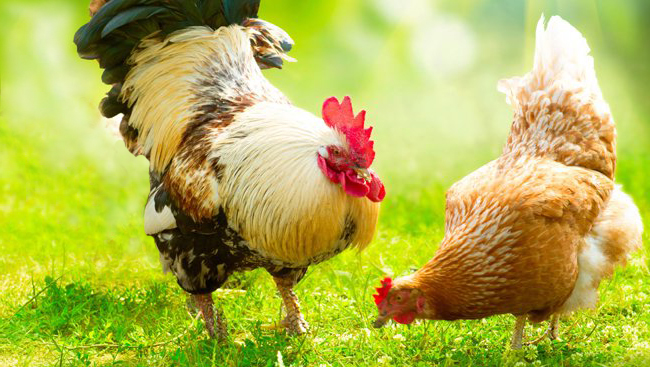
If you are like the majority of our customers then one of the main reasons you are keeping chickens is for egg laying. You may also intend to keep them for their meat, or maybe you like the idea of simply keeping chickens as pets, and any eggs that come your way is purely a bonus!
Your choice of chicken breed depends on why you want to keep chickens, whether for:
• Eggs and meat
• As family pets
• For showing and exhibitions
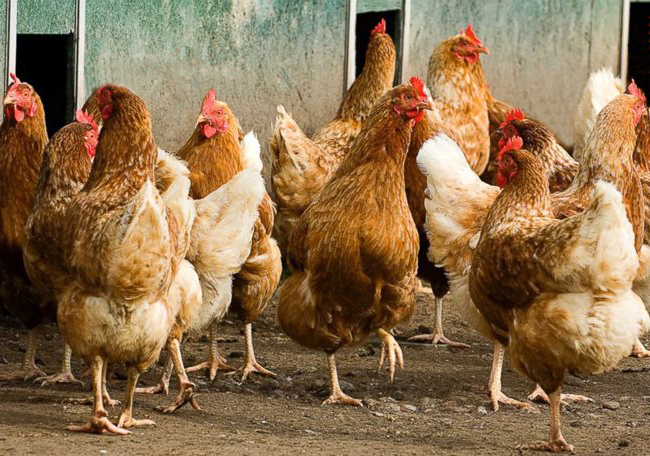
When considering breeds of chickens for meat, eggs or both, you basically have three choices:
1. Laying Breeds
Laying breeds are the best choice if you want eggs above all else. A typical egg laying breed chicken can produce between 180-240 eggs per year per hen. Three hens can therefore produce up to 720 eggs a year, or an average of just under 2 eggs a day.
Your laying hen should start laying eggs at around 5-6 months old, and she will continue to lay at a steady rate for several years. As your hen ages, egg production will slow, as the hen becomes older and ‘spent’.
Laying breeds expend most of their energy during their lives to laying eggs, so spent hens are usually skinny with little real meat on their bones.
However, by choosing a dual purpose breed, you can get good egg production and a fine eating bird too.
2. Meat Breeds
Meat breed chickens are bred for their suitability for the table. If you buy these breeds of chickens, be prepared that they grow very fast, as the faster they grow, the more tender their meat is. Certain meat breed chickens can reach eating weight within just 6 or 7 weeks.
There are three main types of chickens you can raise for meat, known as:
• broilers – butchered at between 3-5lbs in
weight
• fryers - butchered at between 3-5lbs in weight
• roaster - butchered at between 6-8lbs in weight
3. Dual Purpose Breeds
If you want both eggs and meat from your chickens, dual purpose chicken breeds are a great choice for the home chicken owner. Dual purpose breed chickens lay a steady supply of eggs whilst building a decent amount of meat on their bones.
As you might expect, there is some variations between breeds, as some produce more meat than eggs, others the reverse. So, you really can choose the best breed for your family’s needs.
Keeping Chickens As Pets
Chickens can make superb pets for children and adults alike, as they can be affectionate, friendly and some of our customers tell us they even come to them when called. In our breed pages that follow, we have described the best breeds for keeping as pets, and it rather depends on the size of your garden and your children, and how many eggs you wish, as to which breed you choose.
Remember, if you want to keep chickens either as pets or for their meat and eggs, they require proper care just like any other domestic animal. You will need to let them in and out every day, provide them with fresh water, clean bedding and high quality feed, clean their coop out regularly, and inspect them for signs of disease or parasites. When you go on holiday, you will need someone to take over these duties too.
Understanding Chicken Breed Jargon
It has to be said, keeping chickens is a remarkably jargon-free hobby, but there are a few definitions that’ll help you when you are choosing your chicken breeds for the first time.
Chickens come in two main types, bantams and large. Large breeds are on average 20-25% bigger than bantams.
Bantams are divided into classes according to their distinctive features, such as whether they have leg feathers or not. Being smaller than large chickens, they are particularly suitable for keeping in your back garden, and they make great pets for young children. The downside is that their eggs are smaller; the plus side is they scratch about less than their bigger cousins, so you’ll have more lawn left.
Large chickens tend to be in classes according to their original place of origin, such as English, American, Asiatic or Oriental.
Within these classes, chicken varieties are defined by other distinctive features, such as feather colouring or comb style (and a whole lot of other stuff that you only need to know if you want to show chickens or become a chicken breeder.)
Breeds of Chicken
OK, two more important bits of chicken jargon to go; pure breeds and hybrid breeds.
Pure breed chickens are the pedigree chicken breeds, often with flamboyant feathers, striking good looks and an attitude to match. Their breed standards are written down and approved by national organizations, just like pedigree dogs or cats. Pure breed chickens usually don’t lay as many eggs as hybrid breeds, and are generally less docile. As a result, some older, traditional breeds have fallen out of favour, and are quite rare.
As their names suggests, hybrid breeds have been developed by crossing
two or more pure breeds to create a chicken that fulfils a particular function,
such as providing more eggs, or more breast meat. They may not be as good-looking
as the pure breeds, but are often more suitable for your first-time chicken
adventure.
A short guide on the 17 most commonly kept breeds of chickens in the UK.
Below we have put together this easy to read guide to help you. In it we look into the most common breeds of chickens that people keep and their pros and cons.
If this is an area that you are still researching, then you'll find the information in it somewhat useful.
1. Rhode Island Red
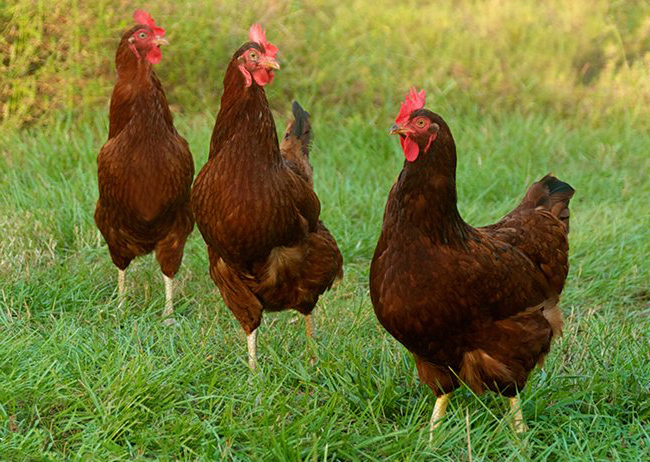
Pure breed chicken
Average Annual Egg Production: 260
Garden Suitability: High, but prefer space given the choice
Best Features: good pets, easy-going attitude, high egg production
The Rhode Island Red originally came from the town of Little Compton in the US state of Rhode Island in the late 19th century, and arrived in the UK in the first decade of the 20th century.
Although originally developed as a dual purpose bird, the Rhode Island Red’s ability to lay up to 260 eggs per year ensured its popularity with commercial egg farmers. They subsequently cross-bred Rhode Island Reds to create new hybrids, such as the Rhode Island/Sussex cross.
If you had to draw a chicken from memory, chances are, it would look like the Rhode Island Red! It’s the ypical chicken shape; deep in the chest, the sort of bird you can tuck under one arm without worry about hurting it. You’ll find this laid-back chicken on farmyards the world over, scratching about with its bright yellow legs, and shaking its rich red feathers in the dust.
Rhode Island Reds may be heavyweights of the chicken world, but they are an active breed. Rhode Island Reds like nothing better than foraging amongst grasses and hedges, and are also surprisingly quiet for heir level of activity. These are tough birds that easily cope with British winters, while their active nature and general alertness makes them interesting pets.
2. Sussex and Sussex Bantam
Pure breed chicken
Varieties: Large: White, Silver, Speckled, Light Red, Brown Buff
Bantam: Columbian, grey, silver, red, porcelain, white, Columbian blue marked
Average Annual Egg Production: 260
Garden Suitability: High
Best Features: docile, high egg production, bantams make good pets.
The Sussex chicken originated in the UK county of Sussex, where they were highly prized for their meat. Today, this long-established breed is a very popular dualpurpose bird, which lays large quantities of eggs. The Sussex is an elegant bird with white skin on their legs, and a medium sized comb. They have a long broad back, deep breast, and their tail should be held at 45 degrees from their body. Cocks weigh about 9lbs and hens less, at 7lbs. Their eggs are cream or light brown.
A Sussex chicken is a fairly laid back bird, docile yet also very interested in their surroundings. They are happy in a coop and run, but given the chance, love to forage as a free-range chicken. Sussex chickens are hardy and don’t mind whatever the British weather throws at them.
Sussex chickens can get broody, but this is a rare occurrence and most
of the time they are happy just to do their own thing. Speckled variety
Sussex chicks take the longest to develop.
The Sussex Bantam has all the great qualities of its larger cousin, but
in a more compact bird. Sussex bantams are well-proportioned birds, and
their loving nature makes them ideal for keeping as children’s pets.
They brood well and are good mothers, should you wish to breed them. Best
of all, Sussex bantams are prolific layers and often continue to lay throughout
the winter when other breeds stop.
3. Barnevelder
Pure breed chicken
Varieties: Black, Double Laced, Partridge and Silver
Average Annual Egg Production: 200
Garden Suitability: Medium – should be free range
Best Features: Tough hardy birds, good layers, good with pets.
Barnevelder chickens were bred in the Dutch town of Barneveld specifically to develop a chicken that laid more eggs, and was also appealing to the UK market. Barnevelders are good-looking chickens, with lovely patterned feathers in golden red and black, bright yellow legs and beak, orange eyes and a small single red comb offset with red earlobes.
Barnevelders can lay up to 200 brown eggs per year, but need to be well exercised as they are basically lazy birds, and easily run to fat. Therefore, they do best as freerange chickens rather than contained within a small run or coop area.
Hens are prone to becoming broody, but this in turn makes them excellent mothers. Their chicks are bright yellow, which kids adore, gradually turning darker as they age.
One of the best points for home chicken owners is that the Barnevelder seems totally unphased by family pets, and are friendly towards them too.
4. Maran
Pure breed chicken
Varieties: Cuckoo (dark, silver, gold), French Wheaten, Copper Black
Average Annual Egg Production: 200
Garden Suitability: Medium – should be free range
Best Features: hardy chicken, easily tamed, chestnut brown eggs.
Maran chickens originate from the French town of Marans, where they were first bred in the mid 1800’s. Originally bred as a dual purpose chicken, the Maran become popular in the UK simply because people liked their dark brown eggs so much! UK breeders developed the breed further in the 1920s into the attractive chicken you’ll see today.
Marans are classed as heavy weight chickens, so they are fairly substantial birds. Most UK bred Marans are said to be cuckoo-coloured, but in fact range from a light silver to a dark grey colour, with a speckled feather pattern. Most Marans for sale in the UK are now dark cuckoo-coloured, the other variations having fallen from favour in the last 50 years or so. All Marans have white legs, and red or orange eyes.
The French Wheaton Maran is gaining popularity for its large chocolate-brown eggs and pretty honey-coloured feathers, perfect for incubating eggs in a nest. French Wheaten Marans can become very tame if you handle them, and will come running if offered food, so they make good pets.
Marans tend to be lazy if given the chance and quickly get fat, so your Marans will benefit from being free-range rather than in a small run. However, they are hardy chickens, happy on rough or marshy areas, so you can pop them in otherwise unproductive corners of your garden.
Marans are a gentle, quiet chicken by nature, and are also disease-resistant, making them ideal if you want a reliable, peaceful free-range chicken breed with high quality meat.
5. Orpingtons
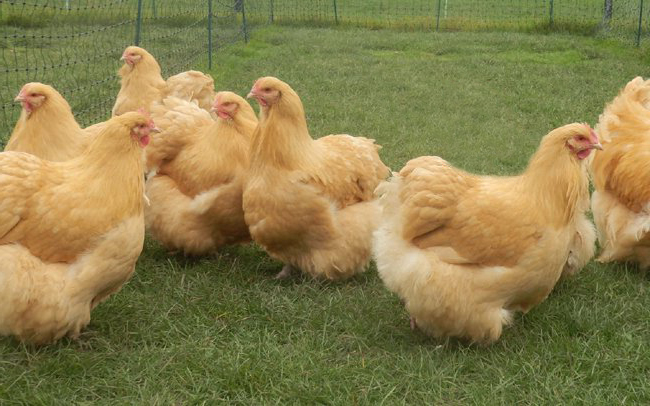
Pure breed chicken
Varieties: Buff, Jubilee, Spangled, Cuckoo, Blue; colourings including Red,
Partridge,
Barred, Gold & Silver Laced
Average Annual Egg Production: 180
Garden Suitability: Medium (large birds, free range only)
Best Features: lovely plumage, docile, good pets. Good show animals
Orpington chickens originate from the town of the same name in Kent. Originally bred just in black, Orpington hens now come in a dazzling variety of colours, including the golden feathers of the Orpington Buff. All varieties have magnificent feathers, but beauty comes at a price, namely a much lower egg yield than other breeds. The Orpington lays attractive smallish pink/beige eggs.
The Orpington is a greedy bird that needs lots of exercise to stay trim, but luckily they also have a small wingspan, so can be contained in an area with low fences.
Orpington hens are disposed to be broody, especially during spring and summer, and hens will sit on a nest all day given half the chance. They therefore make excellent mothers should you wish to raise your own chicks.
6. Leghorn
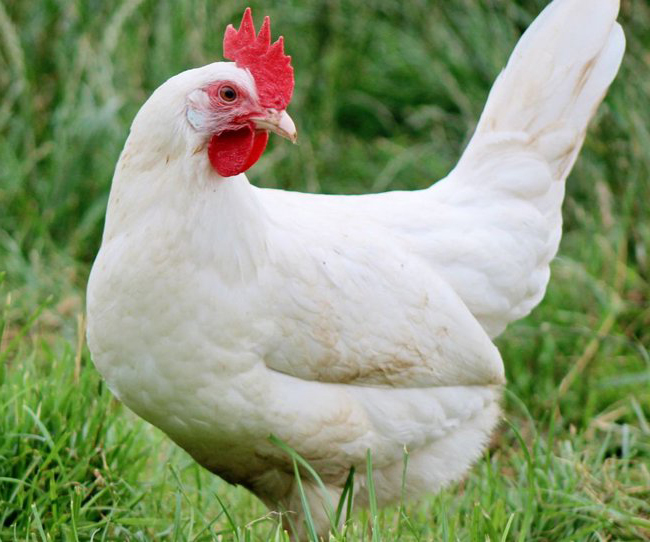
Pure breed chicken
Varieties: White, Light Brown, Dark Brown, Black, & Blue
Average Annual Egg Production: 200
Garden Suitability: Low
Best Features: high egg yield
The Leghorn is an Italian breed, named after the port of Leghorn, from which they were shipped all over the world. The breed was further developed in the USA, arriving in Britain in the 1870s. The Leghorn is usually an all-white bird except for its yellow legs and beak, and coloured facial features.
Like your favourite pair of white jeans (or is that just us?), Leghorns will get dirty and muddy, so don’t keep them if you’re a clean freak, and want your chickens to look as immaculate as your home!
Joking aside, the Leghorn is a superb chicken to keep at home if you love eggs, as they are proficient layers, and lay throughout the winter. It’s no wonder that they are the breed of choice for commercial egg farms, laying eggs as white as their feathers.
Leghorns are not broody, are non-sitters, and continue laying after many other breeds are spent. The chicks mature early, and young hens are ready to lay within four to five months. Legorns are heat tolerant, but hate the cold, so make sure you bring them in during frosty weather, and provide them with a draught-free coop and plenty of bedding.
Leghorns are not ideal for an urban garden, as they are noisy and easily flustered by loud noises or sudden movements. They are rather aloof, and since they can fly, they should be kept in an enclosed run. In the countryside, however, they take quickly to being free-range. They also come in other colours, but no matter their variety, they always lay white eggs.
7. Silkies
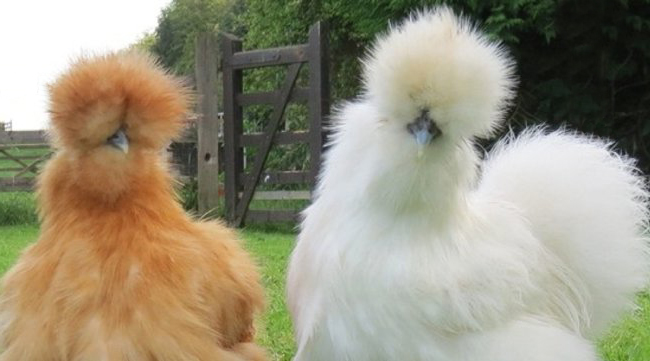
Pure breed chicken
Varieties: Black, Blue, Gold, Partridge, White, in Standard or Bearded
Average Annual Egg Production: 150
Garden Suitability: High
Best Features: Very, very cute! Perfect pets for children
Silkies are an Oriental chicken breed, although whether they originated in Japan, China or Malay is open to debate. Certainly, the explorer Marco Polo reported finding chickens with ‘fur’ on his travels in Asia during the 13th century. Silkies are officially classed as large chickens, but their extraordinary cuddle-ability makes them ideal pets.
In the ‘cute chicken’ stakes, the Silkie wins hands down thanks
to its ‘furry’ appearance. Its feathers stick out like fur and
have no real definition between them, creating the illusion of a Boris Johnson
type haircut! Under a mop of pure white plumage, Silkies have unusual black
faces and skin, black combs, and black feet with five toes covered in yet
more ‘fur’.
The drawback is that their plumage is not waterproof, so they always need
access to a dry coop to retreat to if the weather changes suddenly. However,
the plumage also keeps them warm in winter, so they are reasonably hardy.
It's probably just as well they are cute, as they are not proficient layers, averaging only 150 eggs per year. Silkies are calm and trusting birds who cannot fly, and are perfectly content in a confined space. Unlike any other breeds of chicken, Silkies begin laying in midwinter and completely stop during the summer months. They do turn broody, and as a result, many breeders use them exclusively as foster mothers for other breeds.
Sikie meat is an acquired taste, simply because the meat is as black as their skin. However, in China, this very quality makes the meat highly sought after.
8. Cochins
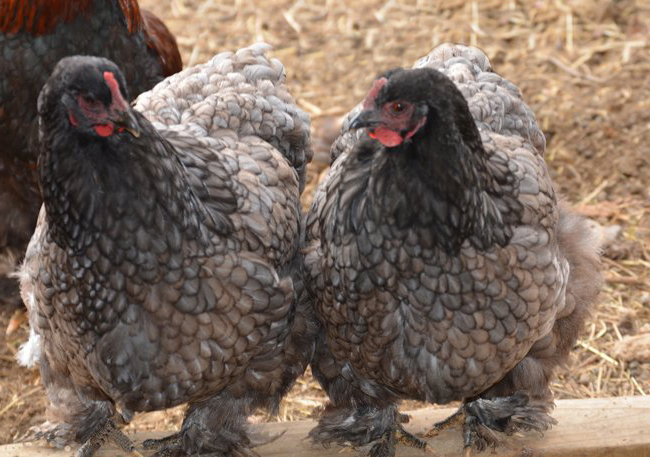
Pure breed chicken
Varieties: Buff, Black, Partridge, Blue, Silver Laced, Splash, Golden Laced,
White, & Frizzled
Average Annual Egg Production: 120
Garden Suitability: medium (due to low egg production)
Best Features: friendly, make great pets
Cochins originate from China, and were first brought to the UK during the reign of Queen Victoria in the 1840s. The Cochin is a heavy, rounded bird, almost plump in appearance, which can affect their general health unless they are kept active and busy. (Cochins are the chicken equivalent of couch potatoes, given the chance!) Cochins do not fly, and are very docile, quite content to be fenced in rather than in a topped run.
Cochins should be kept on short grass, as longer grass or vegetation can
damage their prolific feet feathers. If let out on wet ground, mud balls
can form under their feet feathers, causing feet problems.
Cochins are not great egg layers, but the medium size brown eggs they do
produce are very tasty, so long as you give your birds good quality feed
all year round. So, why would you want to keep a Cochin? Cochins make good
mothers who brood instinctively, and their eggs hatch a day later than most
other breeds, so the chicks are strong from the outset. Chocins can also
be used as foster mothers for other
breeds.
Chocins are quiet chickens, rarely making much more than the odd cluck. Their friendly nature, cuddly appearance and long lives (up to 10 years) make a Cochin an ideal pet too.
9. Speckledy Hen
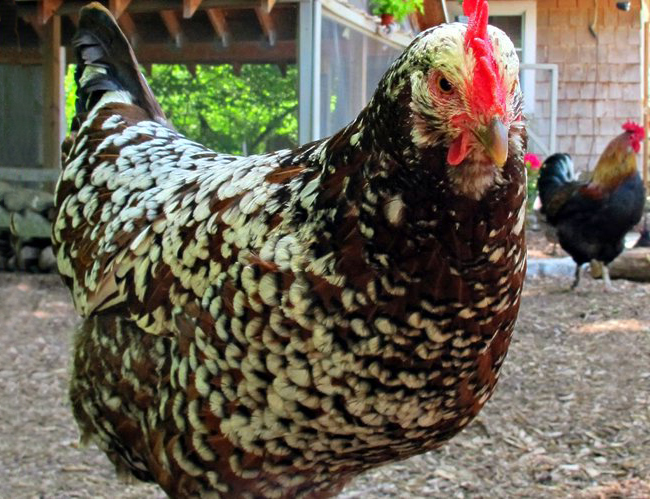
Varieties: cuckoo
Average Annual Egg Production: 250
Garden Suitability: Medium (best free-range)
Best Features: good pets for children, soft feathers, good layers.
Despite its rather ‘traditional’ sounding name, the Speckledy Hen is a modern-day hybrid created by crossing a Rhode Island Red with a Maran.
The Speckledy is a large bird with a classic chicken body shape deep breast, supported on pale legs. The Speckledy has soft feathers, patterned in waves of black and golden brown. Their docile nature and ease of handling makes them good pets for children.
Speckledy Hens lay lots and lots of lovely deep brown speckled eggs, which travel well as they have strong shells. The yolks are also a strong yellow colour, perfect for egg-based dishes such as omelettes and custards.
Speckledy chickens require more feed than other breeds as they are heavy chickens and need lots of energy for their prolific egg-laying habits.
10. Gingernut Ranger
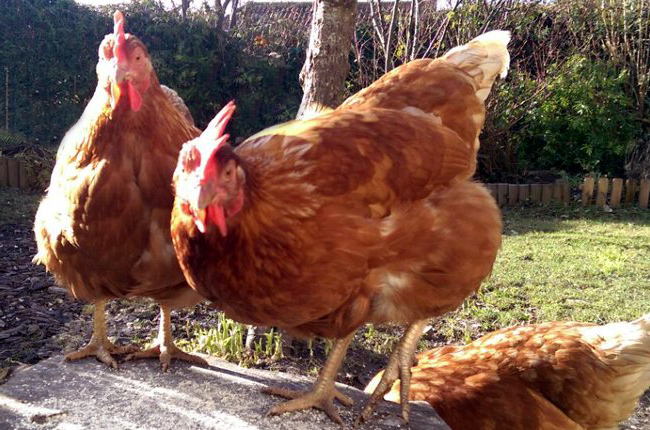
Average Annual Egg Production: 300
Garden Suitability: Medium (best free-range)
Best Features: make excellent pets, very high egg production.
Despite sounding like a kid’s tv show hero, the Gingerbread Ranger is a Rhode Island Red and Light Sussex cross that lays plenty of eggs. Gingernut Rangers are pert birds, with their tails pointing skywards and wings tucked neatly by their side, and pale yellow, smooth legs.
Gingernut Rangers are very tame birds that enjoy following humans around
the garden or farmyard whenever they can. They are hardy chickens with an
inquisitive nature that makes them superb free-range foragers. Children
adore Gingernut Rangers as they are easy to handle and very gentle.
Gingernut Rangers lay large brown eggs at an average of almost an egg a
day, so they are perfect if you want to keep chickens primarily for egg
production.
Gingernut Rangers are a commercial name for this hybrid, which is also known
as a Meadowsweet Ranger, and is similar to a Calder Ranger or Warren hybrid
chicken.
11. New Hampshire Red
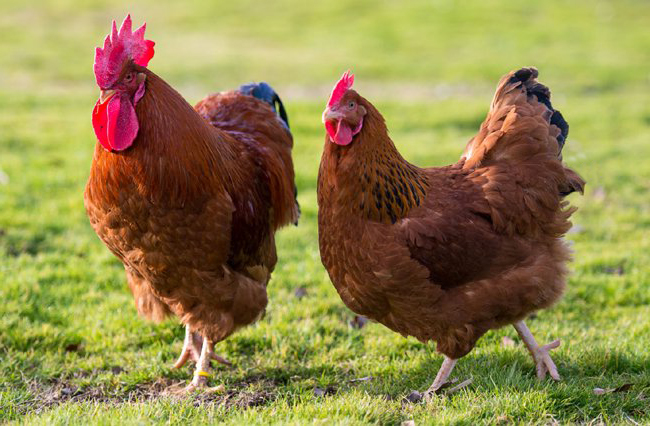
Average Annual Egg Production: 280 eggs a year
Garden Suitability: High
Best Features: excellent dual purpose hens (meat and eggs).
The New Hampshire Red chicken originated from New Hampshire in the USA, where farmers selectively bred Rhode Island Reds to create a bird that matured quickly and laid plenty of eggs. The resulting New Hampshire Red is lighter in colour than a Rhode Island Red, and was bred mainly for eggs, although they have gained a reputation as a good table bird too!
They are handsome and active birds whose full feathers develop quickly. The hens are also easily tamed, with a placid and laid back nature that’s non-aggressive and highly tolerant – very little phases a New Hampshire Red!
New Hampshire Reds are hardy chickens, but their large comb is probe to frostbite in cold weather. They do not fly well, so can be contained within a low fence or in a pen.
The New Hampshire Red is a good dual-use chicken with a bias towards a plump Sunday roast at the end.
12. Plymouth Rock
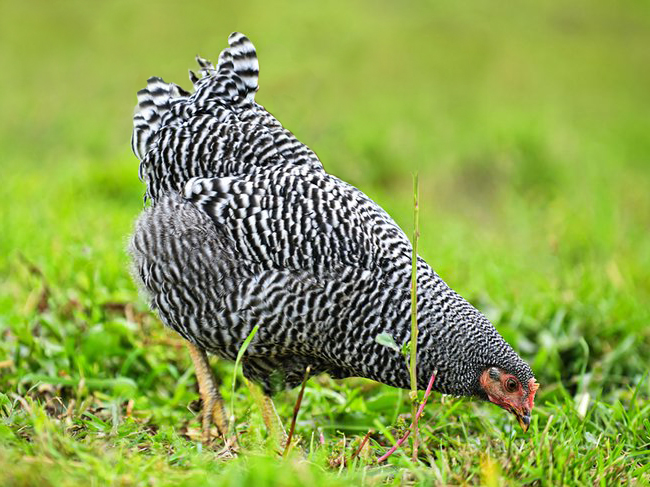
Varieties: Barred, Blue, Buff, Columbian, Partridge, Silver-pencilled &
White
Average Annual Egg Production: 200
Garden Suitability: High
Best Features: suitable as pets, good dual-use.
The original Plymouth Rock chicken was first seen in an American poultry show in 1829, but the Barred variety (named after the bands of colour on its wings) first graced the show scene in 1869. The breed is still very popular in the USA, and is often bred for shows and exhibitions.
The Plymouth Rock is a good dual purpose chicken, laying a respectable 200 creamcoloured eggs a year. With its medium sized breast and long back, it is a good bird for the table too. Egg production does decrease in the winter, but rarely stops altogether.
Plymouth Rock hens can become broody unless eggs are removed swiftly, but are good mothers when given the opportunity. Their chicks grow rapidly for a heavy breed, feathering quickly, and living to a ripe old age too.
Plymouth Rocks tolerate cold weather well, and don’t mind being confined or freerange. Whilst these chickens are friendly and easy to tame, they are also alert and competitive, so they make good pets for the family who want more from their pets than a quick cuddle! However, they should always be tamed to some degree, as they can turn aggressive.
The Plymouth Rock bantam is a just a mini version of the larger bird, a friendly bird laying light cream eggs.
13. Miss Pepperpot
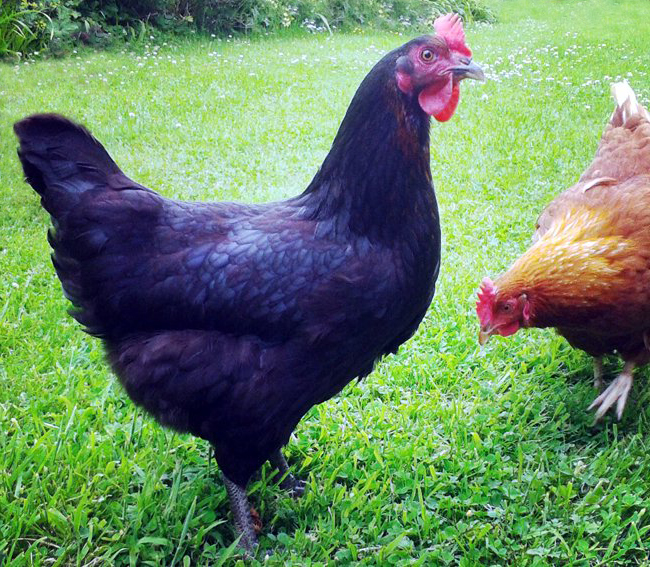
Average Annual Egg Production: 300
Garden Suitability: High
Best Features: disease resistant, hardy, good pets
Despite its rather twee name, Miss Pepperpot is a superb egg-laying hybrid
chicken breed, a cross between A Rhode Island Red, a Maran and a Plymouth
Rock. Miss Pepperpots are only available to buy as hens. (Can you imagine
a cockerel living that name down in the coop?)
Miss Pepperpot chickens have a thick plumage of black feathers with a green tint, topped with a red comb, a black beak and grey legs.
Miss Pepperpot is the perfect bird if you want large brown eggs – and lots of them. These docile chickens are easy to handle, and can be kept in a pen, but thrive best as free-range birds. They are resilient birds too, shrugging off the worst of the British weather, and are resistant to diseases.
As with most docile breeds of chickens, they make good pets; proud owners report how they quickly become one of the family thanks to their inquisitive natures and love of almost anything edible! Owners also report they are good with other family pets such as dogs.
14. Pekin Bantam
Varieties: Lavender, Blue, Silver Partridge, Red Partridge, Blue Mottled,
Columbian, Cuckoo, Mottled, Buff, Black, White & Wheaten
Average Annual Egg Production: 125
Garden Suitability: High
Best Features: full feathers, make great pets.
The Pekin bantam originates from China, although there is no proof to
the story that they were stolen from the Emperor’s private collection
in 1860!
The Pekin is a lovely little chicken that looks much bigger, thanks to masses
of feathers that drop to the ground like a silken coat. They have short
legs and heavily feathered feet. If they were show dogs, they’d be
a Yorkshire Terrier or American Cocker Spaniel, groomed to perfection!
Pekin chickens enjoy human company, and are exceptionally tame. From day one, they settle into new homes extremely quickly and don’t require much space to lead full and happy lives. However, they flourish best when you allow them to graze fresh grass as part of their diet. They are not destructive chicken, preferring to peck gently than scratch and scrabble.
The Pekin tend to be broody, so they can be used as foster mums to other breeds if required. The cockerels are generally good-natured too, and have been known to share incubation duties!
Long-lived and usually very healthy, Pekins hens will even sit in your lap and be stroked. So Pekin hens make good pets for children who want a hen and a friend for life!
15. Japanese Bantams
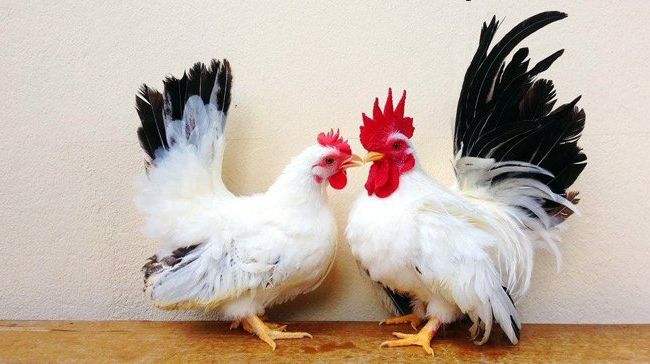
Varieties: Black Tailed White, Black Tailed Buff, Buff Columbian, White,
Black, Birchen Grey, Silver Grey, Dark Grey, Millers Grey, Mottled Black,
Mottled Blue, Mottled Red, Blue, Lavender, Cuckoo, Red, Tri-coloured, Wheaten
Bred, Partridge Bred, Brown Red, Blue Red, Silver and Gold Duckwing
Average Annual Egg Production: very low…
Garden Suitability: High
Best Features: small birds, long-lived, make good pets for children
Japanese Bantams (also known as Chabo bantams) probably originated in
China and were brought to Japan in the early 17th century. The first UK
club for Japanese bantams was established in 1912, although they probably
first arrived here 50 years earlier.
Unlike most bantams, which are miniature versions of a bigger bird, Japanese
bantams are a true dwarf breed with no large equivalent. Japanese bantams
have short legs, vertical tail feathers, a large comb and low wings whose
tips actually touch the ground.
To be honest, nobody really keeps Japanese bantams for their eggs, which are small - and few and far between. Certainly, Japanese bantams are not worth rearing for their meat, as they are small and light. Instead, just keep them for their looks and friendly, trusting nature, or consider showing these exotic chickens.
Japanese bantams are delicate birds that need to be kept warm and dry,
with plenty of clean bedding inside a nice, cosy coop. In winter, they may
even require additional heating, and like all large-combed chickens, their
combs are prone to frostbite. Surprisingly, they are good fliers, so an
enclosed pen or run with adjacent coop is best. Luckily, Japanese bantams
do not dig as much as other breeds, so your lawn
will stay intact if you put the run over it!
Japanese bantam hens are broody and make good, protective mothers. However, the mortality rate of chicks is very high (around 25%), so breeding them is not suitable for beginners.
16. Polish
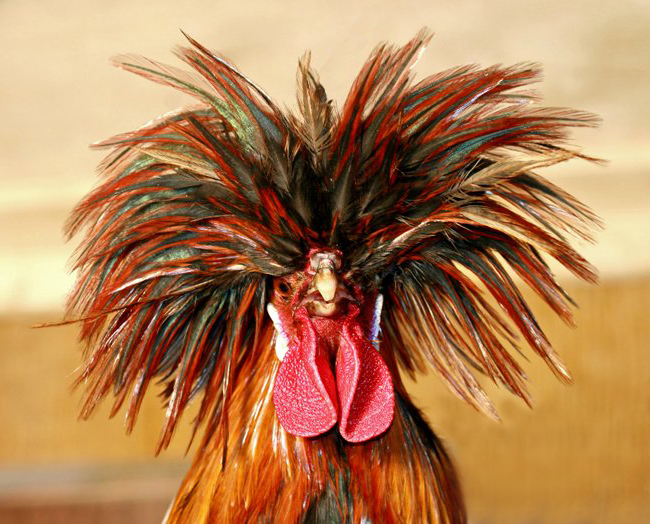
Varieties: Bearded: Golden, Silver, White, Buff Laced. Non-bearded: White
Crested Black, White Crested Blue, Black Crested White, & Golden, Silver,
White, and Buff Laced
Average Annual Egg Production: 120
Garden Suitability: Medium (require some care)
Best Features: great characters, show birds, real talking point
for visitors!
Polish chickens have a long and distinguished history, originating in Asia and brought to Russia by the Mongols in the 12th century. They were originally known as Crested Dutch chickens, as the Dutch traded in them, before they were imported into the UK from eastern Europe. The Polish was shown at the first ever poultry show in London in 1845.
It’s hard to miss a Polish, with its distinctive top-knot of fluffy feathers. In the females, it appears as a sort of rounded hat, but for the males, the crest feathers stick out like a wind-blown bush! (The feathers grow on a cone-shaped protuberance on the top of the chicken’s skull.)
Polish chickens are very friendly and have quite distinctive characters. Due to their head feathers, they often have restricted vision, and so respond to you calling them. In turn, however, they are easily spooked by unexpected loud noises.
Polish chickens get distressed if separated from the flock and have a knack for getting stuck in the most awkward of garden places, so they are best contained rather than free-range.
One solution is to tie up the top feathers with a band (rather than cut
them), so the
chicken can see where they are!
As you might expect, Polish are not hardy birds, and need to have a warm, dry coop to retreat to at all times. If their head feathers get too wet, they can catch cold, so top breeders will often give their prize chickens a quick blow dry with a hairdryer before bedtime!
Polish chickens are not broody, and produce white eggs in moderate quantities,
but most are kept in the UK for exhibition. The most common colouring is
the White Crested black, which (as you might have guessed) has a black body
of feathers topped with a shocking white top-knot.
So out of the 17 breeds above which one is your favourite? Comment below!
7 Readers Comments
Thank you so much your insights have been extremely helpful. We're collecting our girls tomorrow and as you rightly say i'm excited and nervous. Look forward to the next instalment. - Julia Griffin
I'm glad they have helped.- Mike from ChickenCoopsdirect.com
My chicken coop arrived this morning and is already constructed (thanks to your easy to follow instructions.) I can't wait to collect our hens now! I found all the additional email information about the purchase and keeping of chickens really helpful. I am very happy to recommend you Mike to anyone thinking about keeping chickens. Keep up the great work!- Liz.
I have read every word with a big grin on my face - i love hens! Darling Penny my little Wyandotte, silver laced bantam lost her little pal who was brought in from elsewhere and was manic. I caught her trying to swallow a mouse but was unable to retrieve it by the tail. Enough. I am concidering hens again, 3 at most, i thought Black Rock but changed my mind when so difficult to find an agent. I presume it is ok to have 3 different types. I even go 'gooy' when i see a hen house and i love your big-uns with run, tho when i'm in the garden my girls will free range. - Jill
I am enjoying your articles as I prepare to begin keeping a few hens later this year in my new garden. Very easy to read and informative.Thanks again for the helpful guide. -Wendy
These guides are great. I am reading them with great interest planning chickens as the latest addition to our family. I will soon be ordering our coop from you -Louise
Leave a Reply
Your email address will not be published*

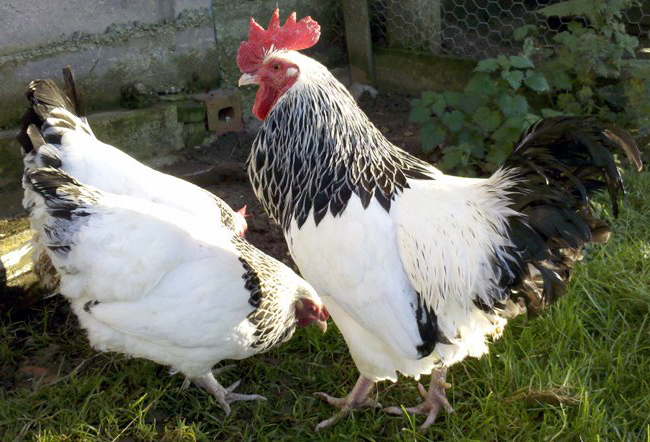
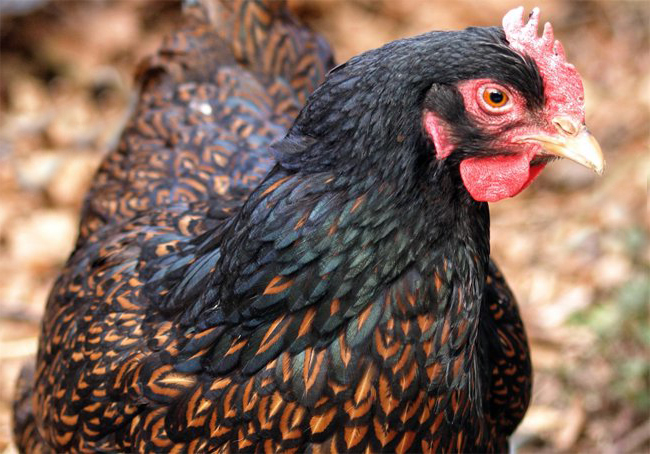
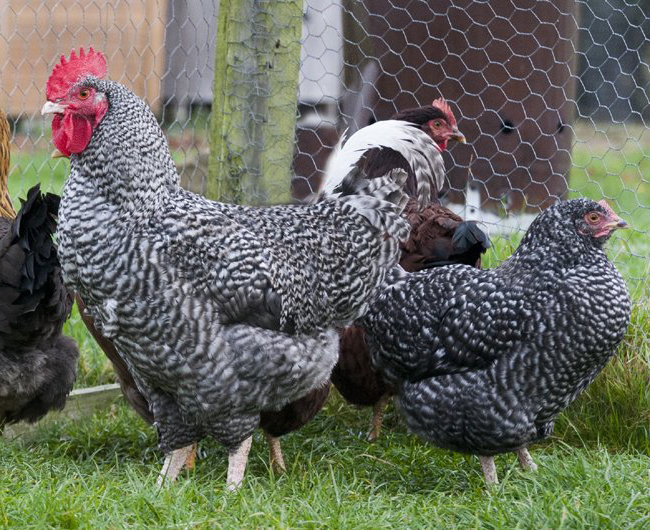
Many thanks for this thoughtful and informative guides. We've been looking forward to having chickens for a while, but were a little unsure what where to start, and what we needed to do. These guides have made the whole process so much easier. We await delivery of our Devon Coop with baited breath, and hope this is the beginning of a great chicken adventure!. - Jim